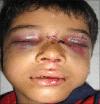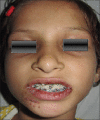A retrospective study of causes, management, and complications of pediatric facial fractures
- PMID: 29988232
- PMCID: PMC6004801
- DOI: 10.4103/ejd.ejd_370_17
A retrospective study of causes, management, and complications of pediatric facial fractures
Abstract
Objectives: The objective of this study was to report causes, management options, and complications of facial fractures among children.
Materials and methods: The groups were defined on the basis of age, gender, cause of injuries, location, and type of injuries. The treatment modalities ranged from no intervention, closed reduction alone or with open reduction internal fixation (ORIF).
Statistical analysis: Descriptive statistics were generated by using SPSS software for the entire range of the variables under study.
Results: Records of 240 pediatric patients were obtained and a total of 322 fractures were found among a study sample. Among these, one-thirds were due to road traffic accidents (RTAs) (37.26%) and fall injuries (36.64%), making them the leading causes of facial fractures. Mandibular fractures were the most common and they accounted for 46% (n = 148) of all fractures. The highest number of RTA (n = 27) was found in adolescents and fall injuries were more prevalent in preschool children (n = 34). Forty-two percent of the fractures (n = 101) were treated with close treatment using arch bars and splints, followed by ORIF (n = 68). The rest, 29.6% (n = 71), received conservative treatments. Postoperative complications were observed in 18.33% (n = 44) of cases, of which jaw deviation, growth disturbance, and trismus were more frequently encountered.
Conclusion: Pediatric facial fractures if not managed properly can cause severe issues; therefore, injury prevention strategies should be strictly followed to reduce pediatric injuries in low socioeconomic countries.
Keywords: Complications; facial fractures; fall injuries; road traffic accident; surgical fixation.
Conflict of interest statement
There are no conflicts of interest.
Figures



Similar articles
-
Non-surgical management of paediatric and adolescent mandibular condyles: A retrospective review of 49 consecutive cases treated at a tertiary referral centre.J Craniomaxillofac Surg. 2020 Jul;48(7):666-671. doi: 10.1016/j.jcms.2020.05.006. Epub 2020 May 31. J Craniomaxillofac Surg. 2020. PMID: 32505527
-
Mandibular fractures in iraq: an epidemiological study.Craniomaxillofac Trauma Reconstr. 2015 Mar;8(1):59-63. doi: 10.1055/s-0034-1384742. Epub 2014 Aug 25. Craniomaxillofac Trauma Reconstr. 2015. PMID: 25709754 Free PMC article.
-
A Retrospective Study on Correlation of Facial Fractures and Type of Trauma in Patients Admitted in Department of Maxillofacial Surgery of Stomatology National and Specialized Hospital, Kabul, Afghanistan.Clin Cosmet Investig Dent. 2025 Jan 18;17:39-48. doi: 10.2147/CCIDE.S501492. eCollection 2025. Clin Cosmet Investig Dent. 2025. PMID: 39845696 Free PMC article.
-
Maxillofacial trauma in central karnataka, India: an outcome of 95 cases in a regional trauma care centre.Craniomaxillofac Trauma Reconstr. 2012 Dec;5(4):197-204. doi: 10.1055/s-0032-1322536. Epub 2012 Jul 31. Craniomaxillofac Trauma Reconstr. 2012. PMID: 24294402 Free PMC article. Review.
-
Complications in the treatment of mandibular condylar fractures: Surgical versus conservative treatment.Ann Anat. 2018 Mar;216:60-68. doi: 10.1016/j.aanat.2017.10.007. Epub 2017 Dec 6. Ann Anat. 2018. PMID: 29223659 Review.
Cited by
-
Oral and maxillofacial injuries in children: a retrospective study.J Korean Assoc Oral Maxillofac Surg. 2020 Jun 30;46(3):183-190. doi: 10.5125/jkaoms.2020.46.3.183. J Korean Assoc Oral Maxillofac Surg. 2020. PMID: 32606279 Free PMC article.
-
Epidemiology of violence in pediatric and adolescent nasal fracture compared with adult nasal fracture: An 8-year study.Arch Craniofac Surg. 2019 Aug;20(4):228-232. doi: 10.7181/acfs.2019.00346. Epub 2019 Aug 20. Arch Craniofac Surg. 2019. PMID: 31462013 Free PMC article.
-
The Treatment Perspective of Pediatric Condyle Fractures and Long-Term Outcomes.Cureus. 2022 Oct 9;14(10):e30111. doi: 10.7759/cureus.30111. eCollection 2022 Oct. Cureus. 2022. PMID: 36381803 Free PMC article.
-
Pattern and management of maxillofacial fractures in Jordanian children and adolescents.Med Oral Patol Oral Cir Bucal. 2023 May 1;28(3):e272-e277. doi: 10.4317/medoral.25712. Med Oral Patol Oral Cir Bucal. 2023. PMID: 36565214 Free PMC article.
-
Characteristics of Maxillofacial Trauma Among Children and Adolescents of South Asia: A Systematic Review & Meta-Analysis.J Maxillofac Oral Surg. 2025 Jun;24(3):597-614. doi: 10.1007/s12663-025-02536-x. Epub 2025 Apr 11. J Maxillofac Oral Surg. 2025. PMID: 40453592 Review.
References
-
- Peden M. World Report on Child Injury Prevention. Switzerland: World Health Organization; 2008. - PubMed
-
- GBD 2013 Mortality and Causes of Death Collaborators. Naghavi M, Wang H, Lozano R, Davis A, Liang X, Zhou M. Global, regional, and national age-sex specific all-cause and cause-specific mortality for 240 causes of death, 1990-2013: A systematic analysis for the Global Burden of Disease Study 2013. Lancet. 2015;385:117–71. - PMC - PubMed
LinkOut - more resources
Full Text Sources
Other Literature Sources

